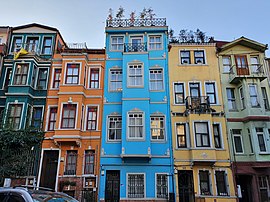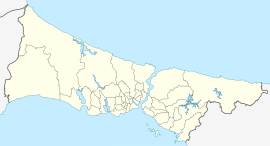You can help expand this article with text translated from the corresponding article in Turkish. (May 2018) Click for important translation instructions.
|
| Balat | |
|---|---|
| Neighbourhood | |
 Balat – colourful houses in the historic center Balat – colourful houses in the historic center | |
  | |
| Coordinates: 41°01′58″N 28°56′44″E / 41.0328°N 28.9456°E / 41.0328; 28.9456 | |
| Country | Turkey |
| Province | Istanbul |
| District | Fatih |
| Population | 11,656 |
| Time zone | UTC+3 (TRT) |


Balat is a neighbourhood in the municipality and district of Fatih, Istanbul Province, Turkey. Its population is 11,656 (2022). It is in the old city on the European side of Istanbul, on the western shore of the Golden Horn, sandwiched between Fener and Ayvansaray. Historically, it was the center of the Jewish community in Istanbul.
The name Balat is probably derived from Greek palation (palace), from Latin palatium, after the nearby Palace of Blachernae.
As in neighbouring Fener, Balat's back streets are lined with small stone two and three-storey terraced houses and a few grander mansions. In the 2010s, Balat become one of the hottest parts of the city for tourism, including domestic tourism, and many of the houses have been turned into cafes, restaurants and accommodation for visitors. Many of the houses have been repainted in bright colours to give a distinctive feel to the neighbourhood.
Balat is a stop on the T5 tramline connecting it to Cibali and the small bus terminal (for services to Anatolia) in Alibeyköy. The Golden Horn ferries also stop here, connecting Balat to Üsküdar, Karaköy, Kasımpaşa, Fener, Ayvansaray, Hasköy, Sütlüce and Eyüp.
History



Balat first became home to a large Jewish population in the late 15th century, when Sultan Bayezid II offered citizenship to Jews and Muslims fleeing the Inquisition in Spain and Africa, and the 1492 Alhambra Decree. At its peak, Balat was home to 18 synagogues, though only three are still in use today: Ahrida Synagogue, Istipol Synagogue and Yanbol Synagogue. Opened in 1899 and designed by Gabriel Tedeşci, Or-Ahayim [tr] Hospital was originally set up to serve Balat's Jewish population, but now serves the general public.
Balat was also home to a wide variety of ethnicities, cultures and religions. The famous Bulgarian Iron Church is located in the district, and there was traditionally a sizeable Armenian population too. Its proximity to St. George's Church and the Ecumenical Patriarchate of Constantinople in neighbouring Fener also meant that there was a large Greek Orthodox (Rûm) population. However, Balat today is overwhelmingly Muslim, with most minority populations having left the district or been forced to leave as a result of the Armenian genocide, Greek genocide, anti-Greek riots and expulsions throughout the 20th century.
From the 17th century onwards European travellers recorded Balat as being particularly poor and unhygienic, although Marie-Christine Bornes-Varol has argued that their reports may not have been accurate reflections of Balat as a whole, since travellers' accounts were largely based on visits to Karabaş, the poorest part of Balat.

In 1810 Balat's Jews attacked the Janissary patrols in the neighbourhood, claiming that they were defending themselves against mistreatment by the local Janissary unit; those who were caught after the attack were executed.
In 1985, Balat was inscribed on the UNESCO World Heritage List as one of the Historic Areas of Istanbul, and in the late 1990s and early 2000s was the subject of a number of controversial renovation and revitalisation projects.
Attractions
The Church of St. Stephen of the Bulgars (AKA The Iron Church) stands on the shore of the Golden Horn where Fener runs into neighbouring Balat and is unique in that it was built entirely from prefabricated iron shipped down the Danube from Vienna and then reconstructed in Balat. It is the base for the Bulgarian Exarchate which broke away from the Orthodox Patriarchate in 1872. The church reopened after complete restoration in 2018.
Originally founded in the 15th century to serve a congregation of Jews from Ochrid, the Ahrida Synagogue contains a beautiful wooden bema (pulpit) and is historically important because it was where Sabbetai Tsvi announced his breakaway beliefs in 1666. Originally built in the 15th century for a congregation of Jews from Bulgaria, the Yanbol Synagogue has a particularly beautiful painted ceiling.
The house of historian Dimitri Cantemir (1673-1723) sits to the right of the steps that form Merdivenli Mektep Sokak. Although it has been restored it has since been absorbed into the grounds of a cafe.
The Church of Hagios Georgios Metochi is enclosed in a large compound off Vodina Caddesi and is usually open on the St George's Day. The original church on the site was probably a chapel for one of the governors of Wallachia but by the 17th century it had apparently become a metochion, closely associated with the Church of the Holy Sepulchre in Jerusalem. It was here that the so-called Archimedes Palimpsest was discovered in the early 20th century when a scholar revealed that seven books written by the Greek mathematician Archimedes had been reused to create a prayer-book in the 13th century. Three of them are not known in any other copies.
The large Armenian Church of Surp Hreşdagabed (Church of the Archangels) was built over an ayazma (sacred spring) in the 16th century but rebuilt in the 18th century. Its 19th-century school building now serves as a warehouse used by the city's rubbish collectors. In his travel book Dervish, the journalist Tim Kelsey described the joint Muslim and Christian gathering that used to take place here on one day of the year when sheep and cockerels were sacrificed in hope of a miracle that would heal a disabled member of the community, an event that no longer occurs.
The Ferruh Kethüda Mosque is a minor work of Mimar Sinan (1562) which contains examples of Tekfur Sarayı tiles around its mihrab. The Balat religious court used to convene in its grounds.
The wrecked Sea Walls of Constantinople cut Balat off from the Golden Horn. On the seaward side a plaque memorialises the point in the walls when Sultan Mehmet II's troops poured over the walls on 23 April 1453 during the battle that culminated in the Conquest of Istanbul.
There are several other rarely used Greek Orthodox churches in Balat including the Church of Hagios Ioannis Prodromos (St John the Baptist) which was closely linked to the St Catherine's Monastery in the Sinai Desert in Egypt.
See also
References
- Mahalle, Turkey Civil Administration Departments Inventory. Retrieved 12 July 2023.
- "Address-based population registration system (ADNKS) results dated 31 December 2022, Favorite Reports" (XLS). TÜİK. Retrieved 12 July 2023.
- Rozen, Minna (2010). A History of the Jewish Community in Istanbul:The Formative Years, 1453-1566. Brill. p. 11.
- AA, Daily Sabah with (2014-10-21). "Istanbul restores Ottoman-Glory Balat district". Daily Sabah. Retrieved 2022-07-04.
- Egger, Vernon (2008). A history of the Muslim world since 1260 : the making of a global community. Upper Saddle River, NJ: Pearson Prentice Hall. ISBN 978-0-13-226969-8. OCLC 144548263.
- Erbahar, Aksel (2010). "Or Ahayim Hospital, Istanbul". Encyclopedia of Jews in the Islamic World. doi:10.1163/1878-9781_ejiw_sim_0017050. Retrieved 2021-06-03.
- "Balat: Living Together". Balat: Living Together. Retrieved 2021-06-04.
- Ortaylı, İlber. "Anılar coğrafyası kıtalara yayılan semt" (PDF). Archived (PDF) from the original on 2021-06-03.
- Mills, Amy (2008). "The Place of Locality for Identity in the Nation: Minority Narratives of Cosmopolitan Istanbul". International Journal of Middle East Studies. 40 (3): 385. doi:10.1017/s0020743808081312. ISSN 0020-7438.
- Bornes-Varol, Marie-Christine (1994). "The Balat quarter and its image: a study of a Jewish neighborhood in Istanbul". In Levy, Avigdor (ed.). The Jews of the Ottoman Empire. Princeton: Darwin Press. p. 639. ISBN 978-0878500901. OCLC 649879656.
- Boyar, Ebru; Fleet, Kate (2010). A Social History of Ottoman Istanbul. Cambridge University Press. p. 121.
- "Technical support for the management, enhancement and development of the Historic Areas of Istanbul, Turkey". UNESCO World Heritage Centre. Retrieved 2021-06-03.
- Bezmez, Dikmen (2008). "The Politics of Urban Waterfront Regeneration: The Case of Haliç (the Golden Horn), Istanbul". International Journal of Urban and Regional Research. 32 (4): 824. doi:10.1111/j.1468-2427.2008.00825.x.
- AA, DAILY SABAH WITH (2022-01-07). "Istanbul's 'Iron Church' stands strong on 124th anniversary". Daily Sabah. Retrieved 2022-07-04.
- "the Archimedes Palimpsest". www.archimedespalimpsest.org. Retrieved 2022-07-04.
- Kelsey, Tim (1997). Dervish (1st ed.). London: Penguin. pp. 97–102.
- Yale 1 Tonguç 2, Pat 1 Saffet Emre 2 (2010). Istanbul The Ultimate Guide (1st ed.). Istanbul: Boyut. pp. 240–43. ISBN 9789752307346.
{{cite book}}: CS1 maint: numeric names: authors list (link)